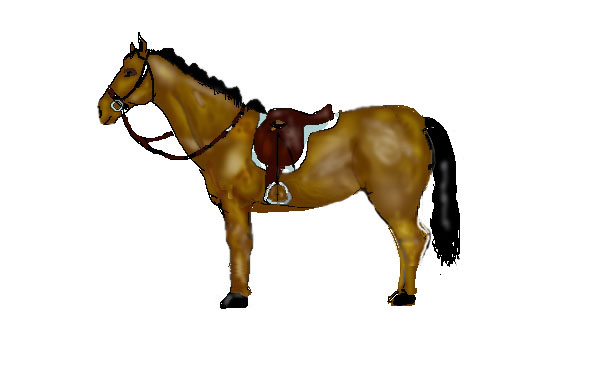
![]() Noseband
Noseband
![]() Pammel
Pammel
![]() Skirt
Skirt
![]() Seat
Seat
![]() Cantle
Cantle
![]() Pad
Pad
![]() Stirrup
Stirrup
![]() Headstall
Headstall
![]() Reins
Reins
English Riding Equipments
 |
|
Some basic requirements for horse riding are shown above.
The above are standard English riding Equipments.
Riders wear comfortable clothing suitable for their type of riding. Their clothing must also prevent them from irritation while rubbing against the saddle. Jeans and a shirt are probably the best for open-country riding. Cowhands often wear Chaps that fit over their regular trousers. They protect the rider's legs from being scratched by the brush.
For English riding, Jodhpurs ( long tight-fitting breeches ) or regular riding breeches are usually worn. They provide both comfort and protection. Boots, or any shoe with heels, keep the feet from slipping out of the stirrups. Some riders wear hard caps( helmets ) to protect their head in case of a fall.
Skilled riders use spurs to signal the horse without moving their legs or heels vigorously. Some riders in horse shows use spursto give commands or to urge their mounts to run faster. Spurs should be worn only by expert riders. Spurs called 'dummy spurs' have either blunt rowels ( little wheels ) or no rowels. Some spurs have sharp points instead of rowles. Racing spurs have rowels on the inside. Rowels on racing spurs and dummy spurs pint downward.Dressage spurs have sharp rowels. They point upwards so that rider needn't shift their feet to touch the horse.
An expert rider use a whip to give the horse special signals or to train the animal. Horse whips are lightweight and flexible and cause no pain if used properly. Horses learn to respond to signals from a trainer's whip when performing different steps and difficult movements in horse shows. Race horses increase their speed at a touch of the jockey's whip. A riding crop may be used like a whip. Crops have stiff handles. The tip is a large loop of rawhide. In fox hunting, riders use a hunting whip, which has a curved, wooden or bone handle at one end and a long leather lash at the other end. The lash is used to control the hounds. Experienced riders apply whips as punishment only if the horse kicks or bites another horse or stubbornly disobeys a command.
Riders in the U.S generally use an English saddle or a western saddle. A person should use the kind of saddle that feels most comfortable or which suits that riders style of riding. Riders who prefer the English saddle like it because it is padded and more comfortable. It is also flatter and weighs less than the Western saddle. Jockeys, jumpers, exhibition riders and others who need extra speed from their horses use the english saddle because it interferes with the horses movement less than the western saddle.
The western saddle has wide stirrups and a horn to which a rope may be fastened. Cowhands and rodeo riders use this saddle. They usually use a double girth ( 2 saddle straps ) on the western saddle to hold it securely against the pull of roped cattle. A blanket under the saddle keeps the horses back and sides from becoming sore. Most western saddles have have fleece padding that also helps protect the horses back.
It is used to control the horse. It consists of straps and metal pieces that fit on the horses head and it's mouth. The simplest bridle is the snaffle bridle. This bridle has a jointed bit that is gentle on the horse. The bit pulls on the corners of the horse's lips. The bridle's single set of reins can be handled easily by the rider.
The double or full bridle is used by advanced riders. This type of bridle has a double set of reins, a snaffle bit and a curb bit. The curb bit fits between the horses teeth on sensitive spaces called bars. This bit puts pressure on the horse's lower jaw. A separate set of reins control each of the reins. The upper reins move the snaffle bit and the lower reins operate the curb bit. Pressure on the snaffle bit causes the horse to raise it's head. Pressure on the curb bit pulls the horse's head down and tbrings the animal to an abrupt halt. Cowhands and Polo players use the curb bit to stop the horse quickly.
Another kind of bridle is the Pelham bridle. It combines the snaffle and the curb bits into one bit with a double set of reins. The art of riding and managing horses is called horsemanship. Many people enjoy riding horseback for fun and sport.
Bit: is the metal part of the bridle that fits in a horse's mouth
Girth: is a leather or canvas strap that fits under the horse's belly and hold a saddle in place.
Hackamore: is a bitless bridle that controls the horse by pressure on it's nose and jaw.
Tack: is riding equipment such as bridle and saddle.